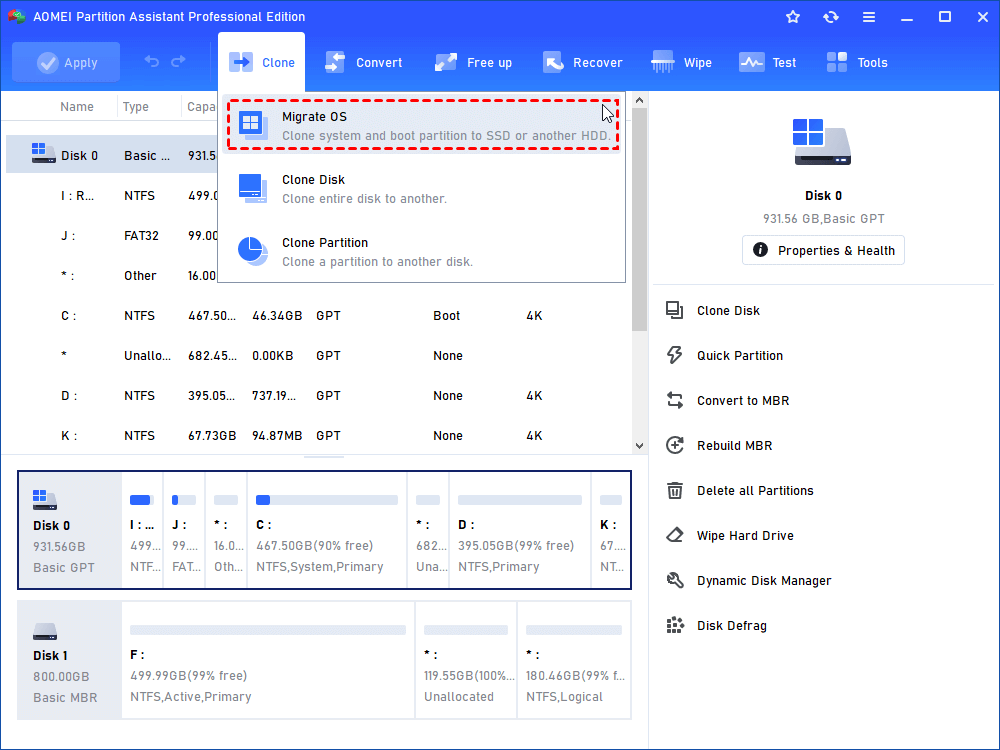How to Migrate OS to mSATA SSD in Windows 11, 10, 8, 7
Do you want to know how to migrate OS to mSATA SSD? Here, you’ll learn to clone HDD to mSATA SSD without reinstalling in Windows 11, 10, 8, or 7.
Why migrate OS to mSATA SSD?
An mSATA SSD is a solid-state drive. Just like SATA, an mSATA SSD transfers data between a computer and the drive via ATA, or Advanced Technology Attachment. You can easily notice the main difference between a standard SSD and SATA SSD in the physical size and connection. So, mSATA SSD is usually favored by ultrabook or other notebook users, and they are willing to clone HDD to mSATA SSD.
As for performance, generally, an mSATA SSD provides 1.5 GB/s to 3 GB/s transfer rate for high running speed. And it can be one of the reasons why people want to migrate OS to mSATA SSD. When you have a new mSATA SSD, you don’t want to lose any data, reinstall Windows, or copy and paste a bunch of data from the old HDD to it. Migrating OS to mSATA SSD is a good way to spare you from troublesome work.
The best way to migrate/install OS to mSATA SSD
The best way to deal with a newly purchased SSD is to migrate Windows operating system to it after installation which saves you from much trouble as mentioned above. But first, you need to put the SSD on the mSATA slot and restart your laptop. Then, how can we perform the OS migration operation?
There is a powerful and practical SSD migration tool named AOMEI Partition Assistant Professional. It is equipped with “Migrate OS to SSD” enabling you to move Windows 11, 10, 8, 7 including all system-related files to another storage device. This tool gives great flexibility with the following highlights and advantages:
● Supports migrating Windows to smaller SSD: SSDs cost more than HDDs on each GB. so you may have a smaller SSD than the internal hard drive, even in this condition, it helps you to clone the system to the destination disk successfully.
● SSD Partition alignment: It is also an SSD partition alignment tool to maximize the best performance if the logical and physical sectors are misaligned.
● Supports multiple SSD brands: You can migrate Windows to Intel, Kingston, Transcend, Samsung SSD.
● Makes the SSD bootable: When you finish the cloning process, replace the mSATA SSD with the old disk, your PC can successfully boot from it.
Then, you can download the Demo Version first and refer to the following tutorial to see how to clone disk to mSATA.
How to migrate OS to mSATA SSD in Windows 11, 10, 8, 7
Now, follow my steps to learn how to finish the OS migration between the old HDD and the new SSD.
Step 1. Open AOMEI Partition Assistant, click “Migrate OS” from the "Clone" option. Then click “Next” when you see introduce note.
Step 2. Choose unallocated space on the mSATA SSD as the destination location to receive this migration. If there is no unallocated space, tick “I want to delete all partitions on this disk”.
Step 3. You can resize the system partition in this window, and click “Next”.
Step 4. And read and remember the boot note.
Step 5. Then you can preview the outcome of it, and click “Apply” to commit the operation.
When the process is complete, shut down your computer or laptop, and unplug the power cable. Then place the SSD into the mSATA socket to install mSATA SSD on your laptop. You may need to remove or keep the old hard drive according to the number of drive slots on your computer. If you want to keep both HDD and SSD, you probably need to enter BIOS to set the SSD as the boot drive.
In addition, if you want to sell or recycle your old disk, it is necessary to completely wipe the old hard drive to protect your personal data from getting hacked.
Conclusion
This is the best way to migrate OS to mSATA SSD in Windows 11, 10, 8, 7. After the process, AOMEI Partition Assistant can also help you to manage your storage space with its many other features, including creating partition, resizing partition, and converting file system between FAT32 and NTFS. Meanwhile, if you want to use this AOMEI product on Servers other than Windows, you can try the Server edition.


